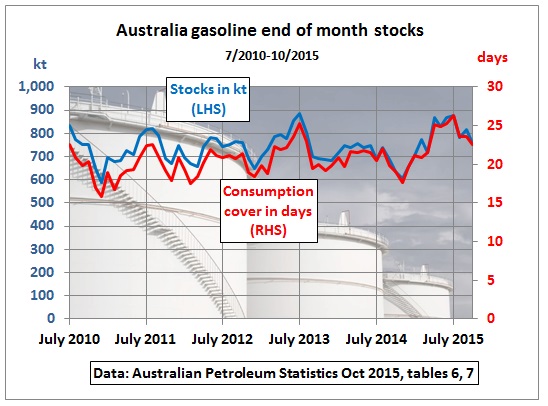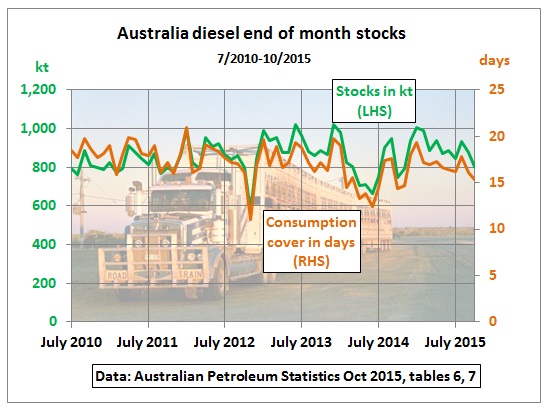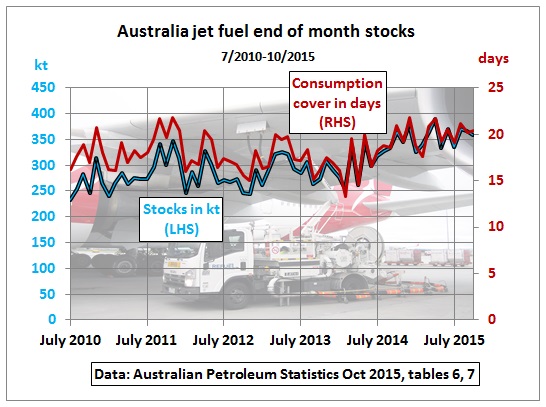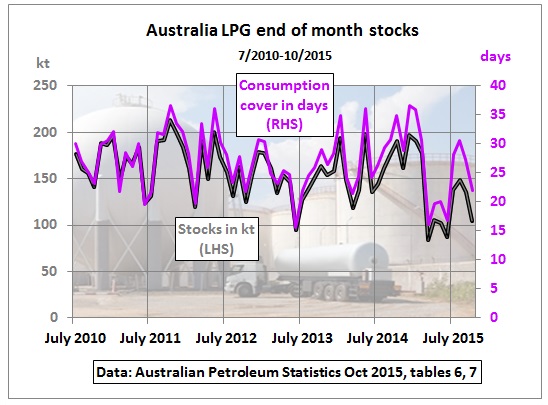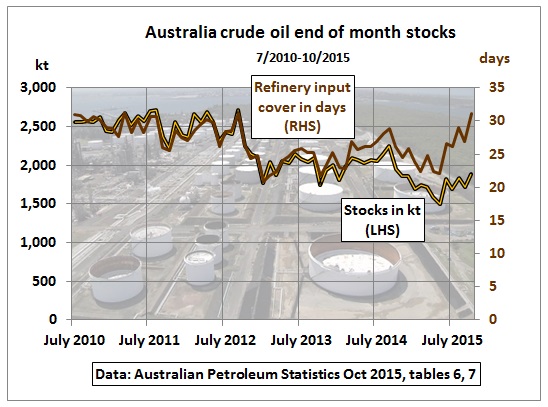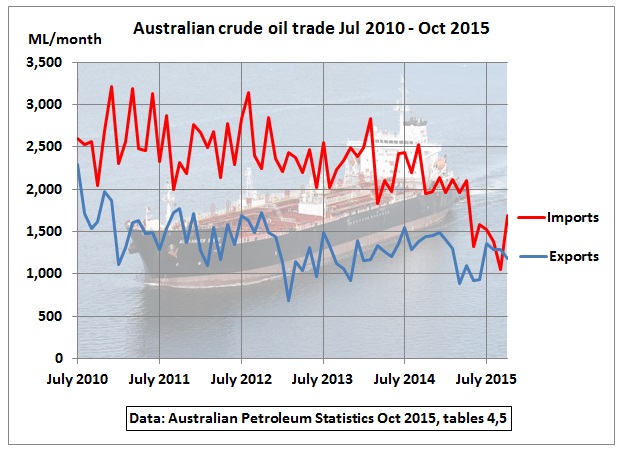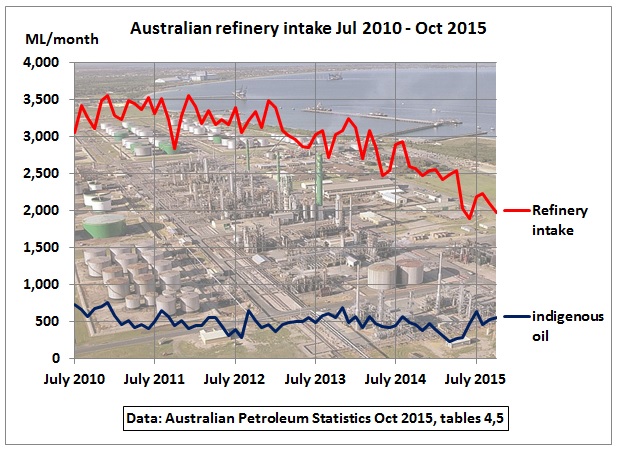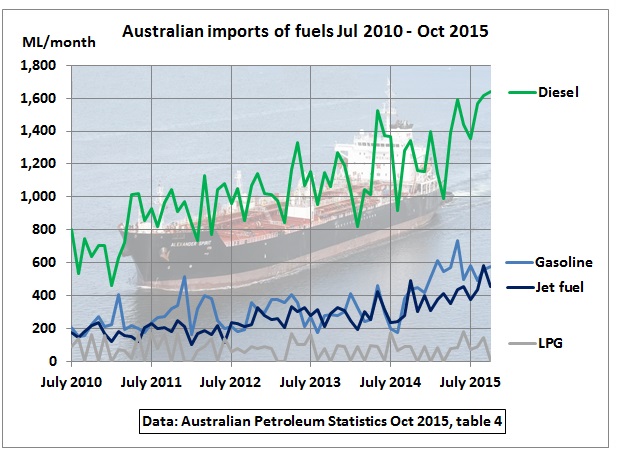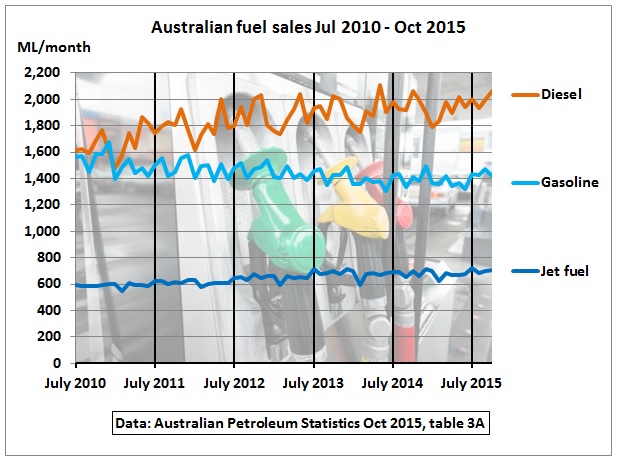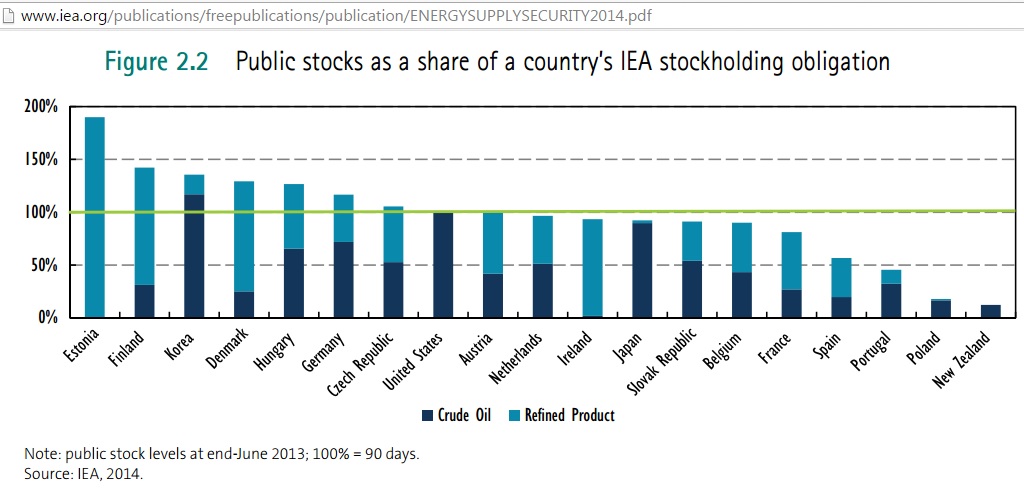The Australian Capital’s daily newspaper Canberra Times started the New Year by reprinting an article of the Daily Telegraph referring to an abundance of oil – without checking whether this also applies to Australia, especially after a year of political football games between a Senate committee and energy bureaucrats on one side and between the Industry and Foreign Ministers on the other, over Australia’s non-existent strategic oil reserve.
So let’s check on Australia’s commercial stocks, using the Australian Petroleum Statistics
http://www.industry.gov.au/Office-of-the-Chief-Economist/Publications/Pages/Australian-petroleum-statistics.aspx of the Department of Industry.
Consumption cover
Fig 1: Gasoline stocks and consumption cover in days
Average Gasoline stocks over 5 years were 740 Kt with seasonal fluctuations of around ±100 Kt (table 6). These stocks cover consumption of around 21 days or 3 weeks (table 7). The month-to-month fluctuations are caused by the arrival of tanker ships.
Fig 2: Diesel stocks and consumption cover in days
Average diesel stocks are 860 Kt equal to a consumption cover of only 17 days.
Fig 3: Jet fuel stocks and consumption cover in days
Average jet fuel stocks are 300 Kt equivalent to 18 days’ consumption.
Fig 4: LPG stocks and consumption cover in days
Average LPG stocks are 160 Kt equal to 27 days’ consumption.
Fig 5: Crude oil stocks and refinery input cover
Crude oil stocks have been reduced after the closure of 2 oil refineries.
The Shell refinery in Sydney (85 kb/d) closed in September 2012 which is about 340 Kt/month.
The Caltex refinery in Sydney (135 kb/d) closed in December 2014 equivalent to 550 Kt/month. So at around one month refinery input in stocks, these refinery closures would explain a drop in stocks of around 900 Kt.
The next refinery closure will be BP in Brisbane (100 kb/d)
Net import cover
As a member of the IEA and a net oil importer Australia is obliged to keep stocks of 90 days of net oil imports (crude and products)
Crude imports
Fig 6: Australian crude imports and exports
Both crude oil imports and exports are declining. Exports, because oil production has peaked in 2000 and is in long-term decline. Imports, because refineries are closing. And refineries are closing because oil production of Shell, Chevron and BP has peaked. Fig 6 shows that in recent months crude imports almost equalled crude exports. This does not mean, however, that in a crisis situation exports could be redirected to replace imports.
Australian refineries can only use around 500 ML of indigenous oil as shown in the following graph:
Fig 7: Australian refinery intake and indigenous share
Fuel imports
Fig 8: Australian imports of fuels
Exports of Diesel, Gasoline and jet fuel are negligible so we look at imports only.
Let’s do some simplified calculations to see how sensitive results are when changing the period under consideration.
..
The import cover for the 3 main fuels differ quite a lot. Surprising is the low cover for diesel. It could be that diesel storage of the mining industry is excluded in the statistics. We also see that the cover drops as fuel imports increase from 2014 to 2015. This can change in future as crude storage facilities are being converted to product import terminals. It is clear that at present Australia is far from 90 days cover.
Fuel Sales
And while we are at it, let’s quickly have a look at where Australian fuel consumption is going.
Fig 9: Fuel sales
Diesel is increasing relentlessly and jet fuel, too. Only gasoline decreased up to mid 2014 but continued steadily since then, presumably due to lower petrol prices. These trends show that Australia is not able or willing to get away from oil. Societal objectives and policy settings are just not there.
Australia and the IEA
Note the above stocks are commercial. Australia has no strategic oil reserve.
From the IEA website on energy supply security
“Australia does not have public stocks, nor is there any minimum stockholding requirement imposed on oil companies operating in the country. The Australian government relies on the normal stockholding practices of the domestic oil industry to meet its 90-day net import obligation as a member of the IEA” https://www.iea.org/countries/membercountries/australia/oilstocks/
Here is the IEA assessment for September 2015, in comparison to other OECD countries in the Asia Pacific
http://www.iea.org/netimports/
The following graph is a comparison with other countries, for public stocks. Australia is nowhere to be seen. New Zealand is at the end of the list
Fig 10: IEA’s assessment of public stockholding obligations
http://www.iea.org/publications/freepublications/publication/ENERGYSUPPLYSECURITY2014.pdf
Flashback: The 2 cents squabble
The public broadcaster ABC TV, who was warned in 2011 by Fatih Birol, chief economist of the IEA that Australia should have prepared for the conventional oil peak already 10 years ago, did not really prepare the public for what has to be done:
Government reveals plan to slug motorists with fuel tax
8/4/2015
The Industry Minister Ian Macfarlane has revealed drivers could face a tax of up to two cents a litre on fuel. That’s because Australia’s oil reserves have fallen well below international standards, and the cost of complying could run into the billions.
http://www.abc.net.au/lateline/content/2015/s4212936.htm
No wonder, the next day:
Cabinet ministers disagree over Australia’s oil reserve
9/4/2015
Conflicting views are emerging within the government over whether motorists should foot the bill for topping up Australia’s depleted strategic oil reserve. Industry Minister Ian Macfarlane says it’ll cost billions, suggesting that Australia should consider walking away from its international commitment to maintain an oil reserve of 90 days supply.
IAN MACFARLANE, INDUSTRY MINISTER: Do Australians want us to remain compliant, do they want us to actually be paying these billions and billions of dollars to be compliant with an international treaty? That’s part of the discussion we’ll be having.
JULIE BISHOP: I don’t believe that the figures that are being put about at present are accurate. I think that much more work needs to be done to determine what it would actually cost in terms of our obligation to meet our treaty.
GINO GRASSIA, INDUSTRY DEPARTMENT: The current size of the oil market in Australia or the stock volume is about 4,000 kilotonnes and the IEA compliance figure would be doubling that.
JOHN RYAN, INDUSTRY DEPARTMENT: The question that’s being asked is: how much are we prepared to pay for the membership of the IEA? That’s the question.
http://www.abc.net.au/lateline/content/2015/s4213716.htm
Senate on Transport Energy Resilience

The Committee room wing of the Victoria Parliament House in Melbourne
On the same day, there was a Senate Inquiry in the Melbourne Parliament House on “Transport Energy Resilience” where the issue of oil stocks was hotly debated and the above representatives of the Industry Department were grilled over the exact numbers.
ASPO Australia was invited to attend this hearing and do a presentation. The response was:
CHAIR: Okay. Gentlemen, I have never been one to beat around the bush. I have no doubt about your expertise and your passion about the use of oil and all, but I think you are in the wrong inquiry.
http://parlinfo.aph.gov.au/parlInfo/search/display/display.w3p;query=Id%3A%22committees%2Fcommsen%2F22c25723-e5d5-4d5f-9e2f-7f329ca8451b%2F0000%22
Here you are. Peak oil has nothing to do with transport energy resilience and stock holdings of companies whose oil production has peaked.
Read Submission #39 for more details which were current at the time:
http://www.aph.gov.au/Parliamentary_Business/Committees/Senate/Rural_and_Regional_Affairs_and_Transport/Transport_energy_resilience/Submissions
The final report of the Committee dated 15/6/2015 recommended
- An updated risk assessment of the availability and vulnerability of fuel supplies
- Requirements for all oil companies to report stocks
- A Transport Energy Plan
IEA deadline passed
An exchange of departmental letters on Australia’s non-compliance and the deadline of June 2015 can be found in this document:
Australia’s International Energy Agency (lEA) Oil Stockholdings
Importance: high
2/6/2015
https://dfat.gov.au/about-us/corporate/freedom-of-information/Documents/dfat-foi-15-22857.pdf
If the (Australian) reader is not happy with how the government avoids – kicking and screaming – to establish a proper strategic oil reserve, it might be helpful to study the following table on how to prepare for the emergency:
https://www.iea.org/publications/freepublications/publication/EPPD_Brochure_English_2012_02.pdf
PT fare reduction: if only a fraction of motorists would switch to public transport, the rail and bus system would collapse
Increase PT service levels: trains are running above 100% capacity during peak hr already now
Carpooling: Toll-way operators will lose revenue and may not be able to roll-over their debt
Telecommuting: Around 17% of employees are already working some of their hours from home and 1/3 of those have formal arrangements with their employer. These shares have remained stable. There is no research to tell by how much this can be increased
1-in-10 days driving ban: Motorists will like this one as this will require to change their lifestyle, i.e. not always driving when they want.
Ecodriving: This means pro-actively driving in such a way that fuel consumption is minimised, a totally new concept for most Australian motorists. This will require attitudinal changes and is a long education process.
Conclusion
The continuing talk of a global oil glut lulls Australian motorists to believe that everything is fine while actually this country’s petroleum stock holdings are minimal. When things go wrong in the Middle East no one will help Australia as IEA obligations have been wilfully ignored by both ALP and Coalition governments.
Related posts
17/10/2014
Sydney’s Caltex refinery closed as Chevron’s crude production and sales continue to decline
http://crudeoilpeak.info/sydneys-caltex-refinery-closed-as-chevrons-crude-production-and-sales-continue-to-decline
23/2/2014
Geelong refinery sold as Shell’s oil production continues to decline
http://crudeoilpeak.info/geelong-refinery-sold-as-shells-oil-production-continues-to-decline
13/4/2011
Australia’s fuel import vulnerability increases as Sydney’s Clyde refinery is closing
http://crudeoilpeak.info/australias-fuel-import-vulnerability-increases-as-sydneys-clyde-refinery-is-closing
9/4/2014
Why the closure of BP’s Brisbane Bulwer refinery reduces Australia’s energy security
http://crudeoilpeak.info/why-the-closure-of-bps-brisbane-bulwer-refinery-reduces-australias-energy-security
Appendix
Explanation of the Closing Oil Stock Levels in Days of Net Imports Table
Each IEA member country has an obligation to have oil stock levels that equate to no less than 90 days of net imports.
Currently, there are three net exporting IEA member countries (Canada, Denmark and Norway) which do not have a stockholding obligation under the I.E.P. Agreement.
The IEA minimum stockholding obligation is based on net imports of all oil, including both primary products (such as crude oil, natural gas liquids [NGLs]) and refined products. It does not cover naphtha and volumes of oil used for international marine bunkers.
The 90-day commitment of each IEA member country is based on average daily net imports of the previous calendar year. This commitment can be met through both stocks held exclusively for emergency purposes and stocks held for commercial or operational use, including stocks held at refineries, at port facilities, and in tankers in ports.
The obligation specifies several types of stocks that cannot be counted toward the commitment, including military stocks, volumes in tankers at sea, in pipelines or at service stations, or amounts held by end-consumers (tertiary stocks). It also does not include crude oil not yet produced.
Member countries can arrange to store oil outside of their national boundaries and include such stocks in meeting their minimum requirement. This option is particularly important for countries in which storage capacity constraints or supply logistics make domestic storage insufficient.
To exercise this option and count the stocks held abroad toward the obligation, the governments involved must have bilateral agreements assuring unconditional access to the stocks in an emergency. When evaluating a country’s compliance with the 90-day obligation, the IEA applies a 10% deduction to its total stocks, net any oil held under bilateral agreements. This accounts for any volumes that are technically unavailable (such as tank bottoms) (see IEA Methodology).
This table provides a view of how IEA member countries are meeting their stockholding obligation in the most recent month for which data is available. By clicking on the country name, a description of that country’s stockholding regime can be found.
https://www.iea.org/netimports/explanations/netimportstable/
